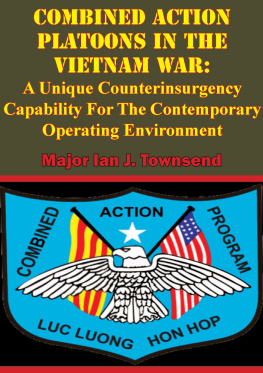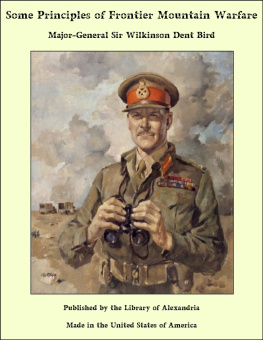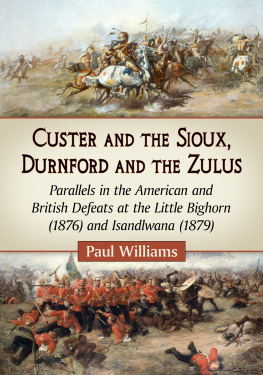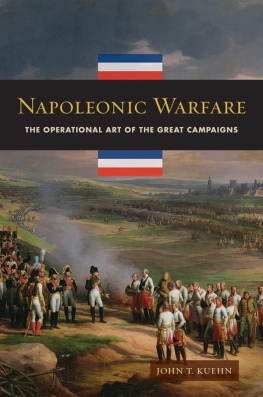
This edition is published by PICKLE PARTNERS PUBLISHINGwww.picklepartnerspublishing.com
To join our mailing list for new titles or for issues with our books picklepublishing@gmail.com
Or on Facebook
Text originally published in 2008 under the same title.
Pickle Partners Publishing 2015, all rights reserved. No part of this publication may be reproduced, stored in a retrieval system or transmitted by any means, electrical, mechanical or otherwise without the written permission of the copyright holder.
Publishers Note
Although in most cases we have retained the Authors original spelling and grammar to authentically reproduce the work of the Author and the original intent of such material, some additional notes and clarifications have been added for the modern readers benefit.
We have also made every effort to include all maps and illustrations of the original edition the limitations of formatting do not allow of including larger maps, we will upload as many of these maps as possible.
MAJOR GENERAL GEORGE CROOKS USE OF COUNTERINSURGENCY COMPOUND WARFARE DURING THE GREAT SIOUX WAR OF 1876-77
By
Major Wesley M. Pirkle, United States Army
TABLE OF CONTENTS
Contents
TABLE OF CONTENTS
REQUEST FROM THE PUBLISHER
ABSTRACT
This thesis will analyze Major General George Crooks performance during the Sioux War of 1876-77 and attempt to answer whether or not Crook successfully fought the Native Americans by effectively implementing the concept of counterinsurgency compound warfare. Counterinsurgency Compound Warfare is the simultaneous use of a regular or conventional force and an irregular, indigenous force in unison against a common enemy. A highly skilled conventional force fighting an insurgency will often face significant cultural, ethnic, linguistic and physical challenges. An irregular, indigenous force can meet many of these challenges by working in concert with the conventional force. Major General George Crook sought to utilize Indian allies outside their traditional roles as scouts and utilized his forces in mutually supporting roles within each forces means and capabilities. The efficacy of an indigenous, irregular force is not only military in nature but, when used appropriately and honestly, this force serves as a vehicle of influence with native populations. The mutually supporting nature of this relationship enhances the strengths of both forces while limiting their inherent weaknesses. This thesis will attempt to explain how Crook was successful when he faced ethnic divisions, interagency rivalry and political hindrances while displaying adaptability as a leader and the ability to continue to learn while fighting a difficult counterinsurgency war.
ACKNOWLEDGMENTS
Any acts of omission in fact or logic are my own. This thesis and any success I may have achieved are due to the unwavering and steadfast love and support of my wife Wendi. My meager accomplishments are unachievable without her. I love you and thank you with all my heart.
I would also like to thank Dr. Jerold Brown, Dr. Thomas Huber and Mr. Paul Gardner for their discerning guidance, constructive criticism and patient assistance. Each of these gentlemen is a distinguished scholar of the warrior profession and I owe them a debt of gratitude that I can never repay. Thank you.
CHAPTER 1 INTRODUCTION
An Introduction to Counterinsurgency Concepts and Major General Crooks Experiences in Counterinsurgency Warfare
Warfare has been described as a continuum that spans the range of conflict from total industrial war on one end of the spectrum to insurgencies and small wars on the other end. An unfortunate by-product of this manner of thinking is that the physical scale of the conflict is construed to be proportional to its importance or complexity. An example is the U.S. Armys Counterinsurgency Manual (FM 3-24) which opens by stating that insurgency and counterinsurgency are a complex subset of warfare. {1} These conflicts are complex, but to consign it to a subset of warfare is an underestimation of the difficulty and complexity required to study and successfully win an insurgency or counterinsurgency. It would is better to state as Steven Metz does; Military thinkers often say that the essence of war does not change. War is and always will be the use of violence for political purposes. {2}
Insurgencies are complex but for it to be relegated to a subset of warfare is to continue an institutional misconception within the U.S. Army. Andrew J. Birtle points out that, Throughout its history, the U.S. Army has focused most of its organizational and doctrinal energies preparing for conventional warfare [but] much of the Armys combat experience prior to World War II was gained not in conventional battles against regular opponents, but in unconventional conflicts against a bewildering array of irregulars. {3} Throughout the majority of the U.S. Armys history small wars and counterinsurgencies have not only been the primary mission, but one could argue that these conflicts were the Armys raison dtre.
The United States has historically been more proficient and successful in conventional warfare but has most often has been called upon to fight a more unconventional opponents. These smaller conflicts have been overshadowed by the large scale, conventional conflicts of the last two centuries. Within the less conventional conflicts, the history of the United States has often underemphasizes or forgotten the longest conflict in our history.
The Indian Wars were a series of conflicts that pre-date the founding of the United States and were in fact specifically mentioned as a grievance in the Declaration of Independence. From the first European settlers to set foot on the North American continent, the conflict with Native Americans was a counterinsurgency war that ran parallel to the development and westward expansion of the United States. It was not just a conflict that was defining the American experience; it was a key formative experience for the U.S. Army during the first 115 years of its existence.
This 200 year North American conflict reached its the most pronounced stage in the twenty five years following the close of the Civil War to the end of the Ghost Dance Uprising (1891). The inevitable conflict between the Native Americans and the expanding frontiersmen was temporarily placed on hold during the mid-19 th century while the nation fought the most costly and defining conflict of that time, the Civil War. As the Regular Army soldiers and officers returned from this difficult and bloody conflict, they were sent to one of three major duties: garrisons in the East, reconstruction in the South or frontier duty in the West. The primary duty for the Army of the West was the facilitation of westward expansion and the pacification or defeat of the Indian tribes that actively fought or resisted this expansion.
During this quarter century period, the U.S. Army often faced a numerically inferior foe that evaded direct confrontations, generally attacked only when it was in his favor and continuously practiced better field skills, use of deception and use of unconventional tactics. Despite meeting this asymmetric foe, the officers of the Civil War period, by and large, continued to fight unconventional Indian warriors with conventional 19 th century tactics. The lessons learned from the renowned Indian fighters of the 17 th and 18 th century were either lost in the lessons gained during first-hand experience in the Civil War or replaced with in the new military innovations and thought brought back from Europe by Dennis Hart Mahan and Emory Upton. The use of strictly conventional tactics in the Indian Wars, while at times successful in some sectors, proved to be costly, slow, and frequently brutal.







